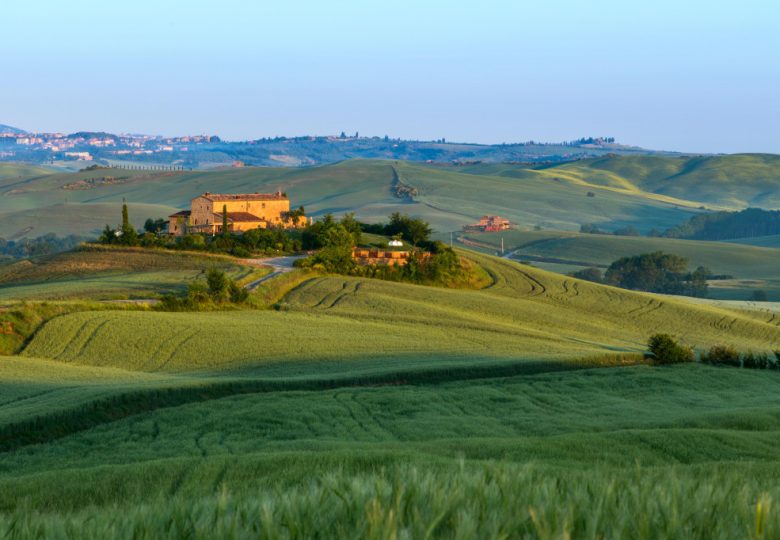Exploring Tuscany

SIENA
A day trip to medieval Siena begins with a walking tour of the tiny city center including the Duomo, the famous Campo square where the Palio is run twice a year, and the Palazzo Pubblico, which boasts one of the most celebrated fresco cycles in the history of art: The Allegory of Good and Bad Government by Ambrogio Lorenzetti. We also explore the picturesque side streets and some of the more hidden spots in town including small, local museums and out-of-the-way churches, shops and eateries. Possible afternoon stops include the hilltop towns of San Gimignano, Monteriggioni or Pienza.
CORTONA
This Etruscan town is perched high on a hill at the border of Tuscany and Umbria on the shores of Lake Trasimeno. A day trip to Cortona includes visits to three of my favorite area churches, Santa Maria Nuova, Santa Maria delle Grazie del Calcinaio, and Santa Margherita, as well as a stroll through the historic center of the city. We also visit one of St. Francis’ most beloved retreats, the oratory of Le Celle, located deep in the countryside outside of Cortona’s walls.
FIESOLE
This ancient Etruscan hilltop city is located just a few miles north of Florence. A visit to Fiesole could include the Romanesque cathedral of San Romolo, the convent of San Francesco located on the site of the Etruscan acropolis, and archeological area featuring the Roman theatre, baths, temple, tombs and museum with numerous artifacts found in the area. Comfortable shoes are a must!
MEDICI VILLAS: PETRAIA + CASTELLO
Both located just a few minutes from the city center, these villas are important domestic examples of Medici power, art and architecture. Villa Petraia contains an important fresco cycle illustrating Medici exploits, the Fiorenza sculpture by Giambologna, a number of works by court portraitist Giovanni Fratellini, as well as decorations dating to the mid-1800s when the villa became the favorite residence of the first king of Italy, Vittorio Emanuele II. The villa di Castello, now the home to Italy’s linguistic academy La Crusca, boasts one of the area’s most stunning gardens replete with monumental sculpture, fountains, grottos, and secret corners used to cultivate rare botanical species favored by the grand dukes.
CERTOSA + GREVE IN CHIANTI + PANZANO
This day trip is a combination of art, history, food and wine. We begin with a visit to the Certosa del Galluzzo, a Carthusian monastery founded in the 1340s, then progress south toward Greve in Chianti, stopping along the way for a tasting at one of the local wineries or to explore one of the area’s ancient castles. We will have lunch at one of Greve or Panzano’s famed eateries before visiting the small 10th century church (pieve) of San Leolino in Panzano and heading back to Florence.
VINCI + MEDICI VILLA CERRETO GUIDI
Leonardo da Vinci was born in the tiny town of Vinci in 1452 and is celebrated there with a museum dedicated to his mechanical inventions. The home where he was born—heavily renovated—may be visited as well. Also in the area is the Medici hunting villa of Cerreto Guidi, an eighth-century fortress remodeled in the mid-1500s probably by architect Bernardo Buontalenti. The villa was the preferred dwelling of Isabella de’ Medici, the highly cultured daughter of Grand Duke Cosimo I who was allegedly strangled here by her husband in 1576. A visit to Cerreto Guidi also allows for a discussion about the importance of the vast network of more than 25 villas that belonged to the Medici family throughout the region.
CERTALDO + BADIA DI PASSIGNANO
The Etruscan/Roman town of Certaldo is best known as the birthplace of the medieval novelliere, Giovanni Boccaccio. His house and library may be visited, as well as the Palazzo Pretorio (city hall) and the deconsecrated church of SS. Tommaso e Prospero which houses an important fresco cycle by Benozzo Gozzoli (1466-67). Nearby is the stunning Badia di Passignano, a massive monastery constructed in 1049 by members of the Vallombrosan reform order. From here, we will take a detour deep into the countryside to visit one of Tuscany’s most intriguing monuments—the small replica of Florence’s cupola built to commemorate the location of medieval city of Semifonte, razed by Florence in 1202.